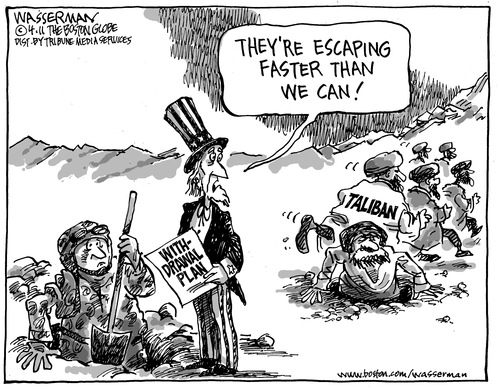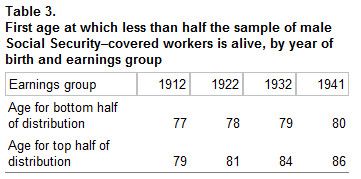There wasn’t much in these files that wasn’t mostly already known. What they did confirm was that there were a lot of people tortured and some innocent people are still in Guantanamo because of that torture.
Newly leaked documents show the ongoing travesty of Guantanamo
by Glenn Greenwald April 25, 2011
Numerous media outlets — The New York Times, The Washington Post, The Guardian, The Telegraph, and NPR, among others – last night published classified files on more than 700 past and present Guantanamo detainees. The leak was originally provided to WikiLeaks, which then gave them to the Post, NPR and others; the NYT and The Guardian claim to have received them from “another source” (WikiLeaks suggested the “other source” was Daniel Domscheit-Berg, a former WikiLeaks associate who WikiLeaks claims took, without authorization, many WikiLeaks files when he left).
The documents reveal vast new information about these detainees and, in particular, the shoddy and unreliable nature of the “evidence” used (both before and now) to justify their due-process-free detentions. There are several points worth noting about all this . . . .
WikiLeaks: Just 8 at Gitmo gave evidence against 255 others
by Tom Lasseter and Carol Rosenberg | McClatchy Newspapers April 25, 2011
WASHINGTON – U.S. military intelligence assessing the threat of nearly 800 men held at Guantanamo in many cases used information from a small group of captives whose accounts now appear to be questionable, according to a McClatchy analysis of a trove of secret documents from the facility.
The allegations and observations of just eight detainees were used to help build cases against some 255 men at Guantanamo – roughly a third of all who passed through the prison. Yet the testimony of some of the eight was later questioned by Guantanamo analysts themselves, and the others were subjected to interrogation tactics that defense attorneys say amounted to torture and compromised the veracity of their information.
Concerns about the quality of the “facts” from the eight men goes to the heart of Guantanamo’s “mosaic” approach of piecing together detainees’ involvement with insurgent or terrorist groups that usually did not depend on one slam-dunk piece of evidence. Rather, intelligence analysts combined an array of details such as the items in detainees’ pants pockets at capture and whether they had confessed to interrogators – American or otherwise.
Just to add to the outrageous actions of the Bush administration, Obama continues along the same path by denying the remaining detainees due process.
DOJ Warns Gitmo Defense Attorneys Not to Use Gitmo Files
by emptywheel (Marcy Wheeler)
The defense attorneys representing detainees at Gitmo in habeas proceedings received this email today.
Subject: Information in the public domain 2nd reminder
All:
As many of you have undoubtedly heard or read, government documents that may contain classified information have been released via the news media. As a reminder, information that is marked as classified, or that a person with access to classified information knows to be classified, remains as such despite a potential public disclosure by unauthorized means. Classified National Security Information only becomes declassified when the appropriate original classification authority makes their determination that the information may no longer cause damage to national security and may be declassified. Accordingly, consistent with your Classified Information Nondisclosure Agreements and Memorandum of Understanding that you signed as a participant in the Guantanamo Habeas proceedings, counsel are hereby cautioned that this presumptively classified information must be handled in accordance with all relevant security precautions and safeguards, including but not limited to, use and preparation in the Secure Facility and filing under seal with the Court Security Officer.
Thank you.
Court Security
In other words, in spite of the fact that the entire world now sees the flimsy evidence on which many Gitmo detainees are being held, Gitmo detainees’ lawyers can’t use that now very public information to defend their clients without going through the court security officer first. In fact, they can’t even talk about this information, for example in public appearances to explain their client’s plight, without asking the government for permission first.
And this gem from Marcy that further restricts the tools that any defense attorney in a civilian court could use to refute the prosecution’s evidence:
While some of the changes are just procedural, others are more telling. A central difference is the assertion that everything a High Value Detainee says will be presumptively treated as Top Secret/SCI (an update to the DC District order, issued before Abu Zubaydah’s lawyers got materials in his habeas case, includes treatment of TS/SCI information). So anything al-Nashiri tells his attorney about the torture he suffered-including the torture still allegedly being investigated by DOJ-will be considered TS/SCI.
In a similar vein, the prohibition on sharing detainee statements in classified documents I mentioned earlier is an addition to the DC District order.
Statements of the detainee that detainee’s counsel acquires from classified documents cannot be shared with the detainee absent authorization from the appropriate government agency authorized to declassify the classified information.
None of this would stand in a civilian court but that is not to say that the DOJ couldn’t get convictions. There are clearly cases where they could but it would be harder. Military commissioned tribunals are easier because they make up the rules as the circumstances change. Then there are those who will be held indefinitely, regardless of a lack of evidence or, quite possibly because that evidence is so tainted it could never be used in any court military or otherwise, Way to go there , Con-law professor.

 Katrina vanden Heuvel:
Katrina vanden Heuvel:  While everyone was focusing on the bogus issue of President Obama’s citizenship and busily examining the authenticity of the newly released long form, there was a national security shake up going on that finally got it’s 5 minutes of attention by the media. Defense Secretary Robert Gates had announced that he would be leaving the Pentagon this year. There was some speculation about his replacement that included Secretary of State Hillary Clinton. She has since made it clear that she was not interested and would remain in the critical job steering Obama’s rudderless foreign policy. By law, the Defense Secretary must be a civilian and disqualified if having served in the military in the last 10 years, thus eliminating any of the current or recently retired generals.
While everyone was focusing on the bogus issue of President Obama’s citizenship and busily examining the authenticity of the newly released long form, there was a national security shake up going on that finally got it’s 5 minutes of attention by the media. Defense Secretary Robert Gates had announced that he would be leaving the Pentagon this year. There was some speculation about his replacement that included Secretary of State Hillary Clinton. She has since made it clear that she was not interested and would remain in the critical job steering Obama’s rudderless foreign policy. By law, the Defense Secretary must be a civilian and disqualified if having served in the military in the last 10 years, thus eliminating any of the current or recently retired generals.  On this day in 1805, Naval Agent to the Barbary States, William Eaton, the former consul to Tunis, led an small expeditionary force of Marines, commanded by First Lieutenant Presley O’Bannon, and Berber mercenaries from Alexandria, across 500 miles to the port of Derna in Tripoli. Supported by US Naval gunfire, the port was captured by the end of the day, overthrowing Yusuf Karamanli, the ruling pasha of Tripoli, who had seized power from his brother, Hamet Karamanli, a pasha who was sympathetic to the United States.
On this day in 1805, Naval Agent to the Barbary States, William Eaton, the former consul to Tunis, led an small expeditionary force of Marines, commanded by First Lieutenant Presley O’Bannon, and Berber mercenaries from Alexandria, across 500 miles to the port of Derna in Tripoli. Supported by US Naval gunfire, the port was captured by the end of the day, overthrowing Yusuf Karamanli, the ruling pasha of Tripoli, who had seized power from his brother, Hamet Karamanli, a pasha who was sympathetic to the United States. Dean Baker:
Dean Baker: 
Recent Comments